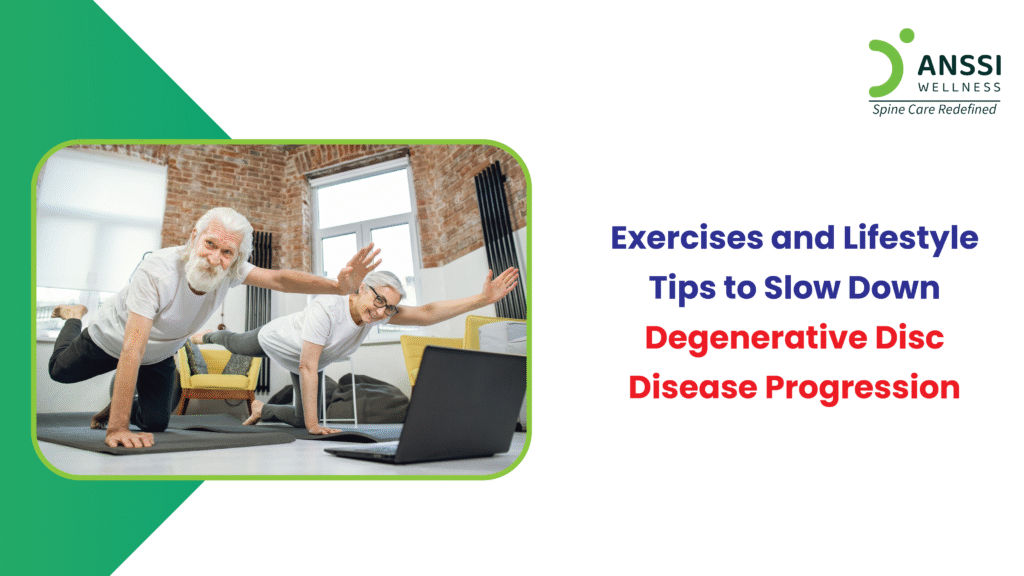Degenerative Disc Disease (DDD) is a common condition that occurs as part of the natural ageing process. It refers to the wear and tear of spinal discs, which act as cushions between vertebrae. Over time, these discs lose hydration and elasticity, leading to pain, stiffness, and limited mobility.
While DDD cannot be reversed, a combination of targeted exercises and positive lifestyle choices can significantly slow its progression and reduce its impact on your daily life.
Effective Exercises for DDD Management
Regular physical activity strengthens the muscles that support the spine, improves flexibility, and helps maintain mobility. The following low-impact exercises are particularly beneficial for individuals with DDD:
1. Walking
Walking is a gentle, weight-bearing aerobic exercise that improves circulation, strengthens lower back muscles, and promotes disc hydration. A brisk 20-30-minute walk daily can enhance spinal stability without adding stress.
2. Stationary Exercise Biking
Stationary biking offers cardiovascular benefits with minimal impact on the spine. It helps maintain overall fitness and supports weight management, which is crucial for spinal health.
3. Hamstring Stretch
Tight hamstrings can pull on the pelvis and increase pressure on the lower back. Stretching them relieves tension and enhances flexibility. Try seated or lying hamstring stretches while keeping the movement controlled.
To do this:
- Sit, extend one leg, and reach forward gently.
- Hold 20-30 seconds per side.
4. Cat-Cow Stretch
This yoga-inspired stretch improves spinal mobility and reduces stiffness. It involves alternating between arching and rounding the back, helping loosen the spine and increase flexibility.
To do this:
- On hands and knees, arch and round your back alternatively.
- Perform 10-15 cycles.
5. Back Extension
Back extensions target the lower back muscles and can strengthen the lumbar area, offering more support to the affected discs. Perform them gently while lying on your stomach.
To do this:
- Lie on your stomach and straighten your legs.
- Lift the upper back and press your hips.
- Hold for 30 seconds and resume the starting position.
6. Knee-to-Chest Stretch
This stretch helps relieve pressure in the lower back.
To do this:
- Bring one or both knees to the chest while lying on your back.
- Hold the position for 20-30 seconds.
7. Bird Dog Stretch
This core-stabilising exercise enhances balance and strengthens the muscles surrounding the spine.
To do this:
- Begin on all fours and alternate extending the opposite arm and leg.
- Hold briefly before switching sides.
8. Pelvic Tilts
Pelvic tilts engage the abdominal and lower back muscles, improving lumbar stability.
To do this:
- Lie on your back with your knees bent.
- Tighten the abdominal muscles to flatten your back against the floor.
10. Lower Trunk Rotation
This movement promotes spinal flexibility and relieves stiffness in the lower back.
To do this:
- Lie on your back with knees bent.
- Gently rotate the knees from side to side.
Precautions While Exercising
Although these exercises are safe for most people with DDD, it’s essential to follow certain precautions:
- Consult a Specialist: Always speak with a physical therapist or doctor before starting any new exercise routine.
- Start Slow: Begin with a few repetitions and gradually increase as strength improves.
- Focus on Form: Performing exercises with correct posture prevents additional strain on the spine.
- Avoid High-Impact Movements: Jumping, heavy lifting, or twisting motions can worsen disc degeneration.
- Listen to Your Body: Stop immediately if you experience sharp pain, numbness, or discomfort during any exercise.
Sticking to a consistent, well-guided routine can enhance outcomes and prevent setbacks.
Lifestyle Tips to Support Spinal Health
In addition to exercise, adopting healthy habits is crucial for managing DDD. These lifestyle changes can significantly reduce symptoms and prevent further degeneration:
1. Quit Smoking
Smoking reduces blood flow to spinal discs and accelerates degeneration. Putting a stop to your smoking is one of the most impactful steps you can take for spinal and overall health.
2. Manage Your Weight
Extra body weight increases the load on your spine, particularly in the lower back. Maintaining a healthy weight through diet and exercise reduces disc stress and inflammation.
3. Lift with Care
Avoid lifting heavy objects unnecessarily. When lifting is unavoidable, use proper techniques; bend at the knees, keep the back straight, and hold objects close to the body.
4. Ensure Healthy Diet
Eating a diet rich in anti-inflammatory foods, such as fruits, vegetables, lean proteins, and healthy fats, supports disc health. Nutrients like calcium, vitamin D, and omega-3s play a key role in bone and joint health.
5. Staying Active
A sedentary lifestyle contributes to muscle weakening and poor posture. Staying active with low-impact movements like swimming, cycling, and walking helps preserve spinal function.
6. Mindfulness and Stress Reduction
Chronic stress can increase pain sensitivity and muscle tension. Practices like yoga, meditation, and deep breathing not only ease mental stress but also contribute to physical relaxation and pain management.
About ANSSI:
ANSSI Wellness focuses on improving the quality of life for patients suffering from spinal issues, aiming to provide relief where other conventional treatments have failed. Through advanced non-surgical spinal decompression treatment, ANSSI is committed to helping patients avoid surgery and recover in a safe, effective, and compassionate environment.
Connect with ANSSI Wellness on LinkedIn, Instagram, and Facebook for expert guidance.



